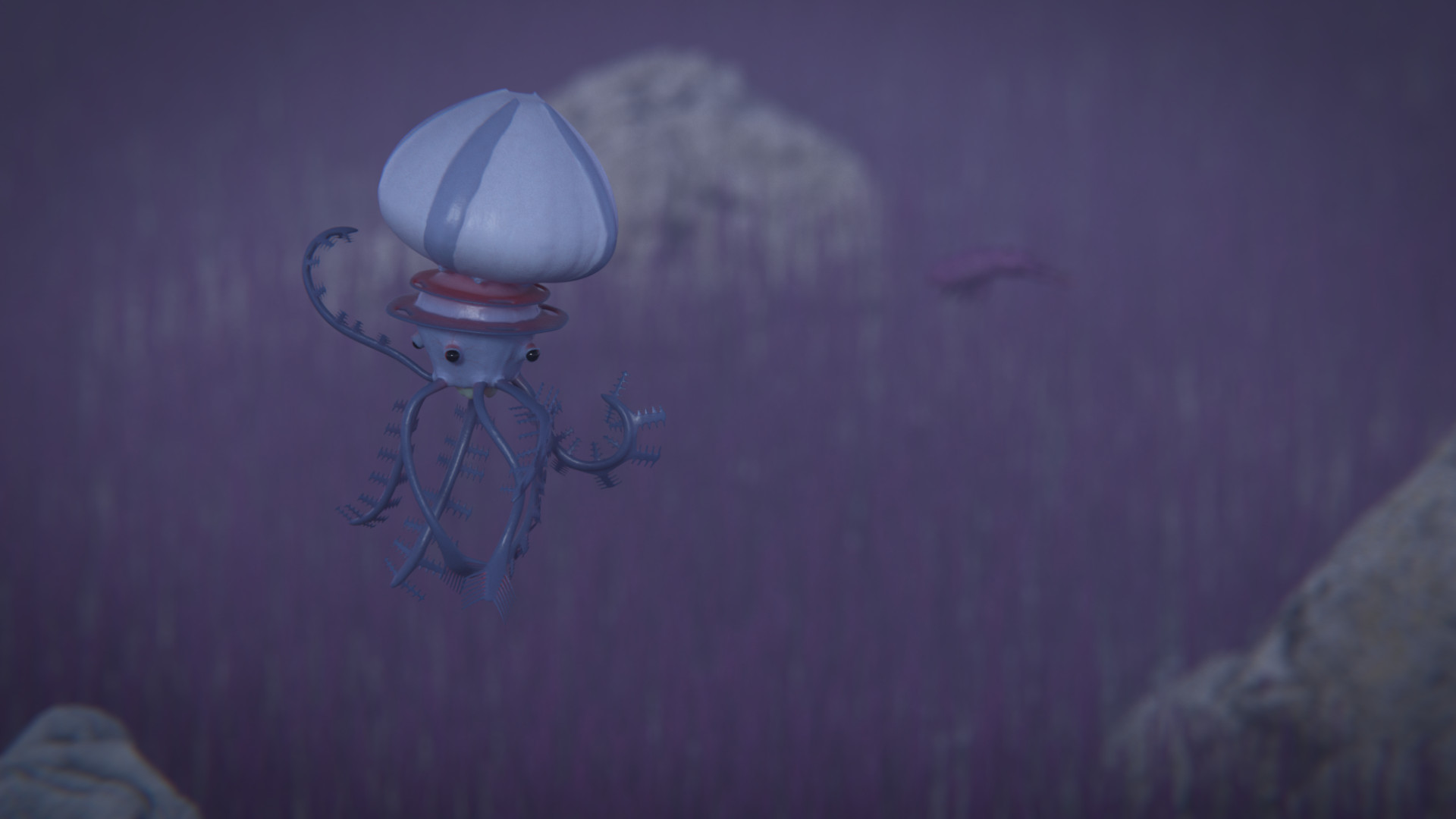Ecoglobe
An ecoglobe has descended towards the spiral plant fields in search of food. [Creature design by Lord of Leviathans]
Basic Information
Anatomy
Ecoglobes have developed two main specialized organs which differ from their ancestors, the filter globes.
The first is the specialized tentacles. Of the 8, 6 have developed the 7 protrusions on the tentacles to be more sturdy and flexible, and slightly longer as well, with four hair-like follicles protruding from those main protrusions. The other two have evolved the protrusions to be closer to the end of the tentacle, bunched up and being equally as sturdy, but less flexible. The ends of these tentacles also have muscles at the end which expand and contract at opposite ends, allowing the ends of these 2 tentacles to act as claws which open and close.
The second specialization is the gills. These have evolved to be a total of 20 chambers. Each quadrant of the creature has one main chamber, which extends up the length of the bulbous dome on the creature. On the lower area, on each side of this chamber are two more chambers, making a total of 5 chambers on each quadrant. The two chambers which are bunched together (in the top chamber) act to expand and bring in fresh water, which is then moved into the larger main chamber, and to (in the lower chamber) expel waste water which has been de-oxygenated. This allows for respiration, but also as an added bonus, these main chambers can be squeezed to force water out, which allows for a propulsion in a certain direction.
The rest of the organs include eyes, mouth, stomach, reproductive sac, hearts, and brain. The eyes have grown to protrude more outwards from the body, allowing the creature to have a more focused vision in a certain area. This can allow the creature to see a predator coming, or to hunt prey. The mouth of the creature has also been extended from the main body. It consists of four “jaws” which are a more sturdy casing than the rest of the body has. The jaws can open and close at will with the aid of muscles at the base. Above the mouth is the stomach, which has another muscle allowing the “throat” area (between the mouth and the stomach) to open or close at will. The stomach also has a layer of muscle surrounding it, allowing the stomach, in coordination with the mouth and throat, to suck in the water in the vicinity of the throat. Usually, this will allow the creature to inhale its prey, and lead it into the stomach, where all digestible items will be digested. The rest is left in the stomach, and when all that can be digested is digested, the stomach will be squeezed by the surrounding muscles to expel all waste left over. The heart and brain of the creature are much the same as their ancestors.
The body of the Ecoglobes consists of soft, spongy tissue which is very lightweight and squishy. This means Ecoglobes are easy prey for other creatures, but if they survive, they will be able to regenerate extremely quickly. The horizontal diameter of the balloon of the creature can be as large as a little more than a foot.
Genetics and Reproduction
Ecoglobes use a spawning mechanism modified from the ancestral broadcast spawning. However, when the gametes are expelled, they get caught in the tentacles of the creature. During the mating season, any number of creatures will entangle their tentacles, allowing for multiple genes to be passed into the next generation. Some may come from the same parent, and will be more or less clones, while others may have a wide diversity of genes. The young ecoglobes will cling to the parent they originally rested on. They may consume smaller creatures which inhabit this area, and may also be consumed by the larger creatures that sometimes wander in. However, because the creatures spawn by the hundreds per individual, much of the generation is kept alive, usually surviving to numbers around a dozen to even 50 before reaching maturity. Upon reaching maturity, the ecoglobe will finally detach from its parent, and will begin its own life.
Ecology and Habitats
Ecoglobes could be considered mini habitats. The smallest fibers of the tentacles of the ecoglobe are able to entangle microscopic organisms, which are consumed by larger organisms, which are consumed by yet larger organisms and the young ecoglobes. These are then consumed by larger organisms, which the adult Ecoglobes feed on. An ecoglobe’s tentacles are often times entangled with Spiral Plants growing around them, allowing for kirbirb to swim around in them and hide from predators. Aside from this, the ecoglobes use their lightweight and large balloon to float to the very surface of the ocean, sometimes slightly lower. Their main habitat is the coastal shores of the northern Natash peninsula, to the coastal shores of Eastern Cha Ttang and southern shores of Arctica.
Ecoglobes live in ballons, very similar to their ancestors. However, a single ballon may contain about 20 ecoglobes at one time on average.
EXTINCT
Genetic Ancestor(s)
Genetic Descendants
Scientific Name
Xenoteuthis gardensis
Origin/Ancestry
Xenoradiata
Average Height
The main body of an adult is about 30cm long, with the tentacles being an aditional 30cm.
Body Tint, Colouring and Marking
Ecoglobes have adopted a paler coloring from their ancestors, being more light blue. From below, this will camouflage the creature, aiding to prevent predation.
Geographic Distribution
Remove these ads. Join the Worldbuilders Guild











Comments